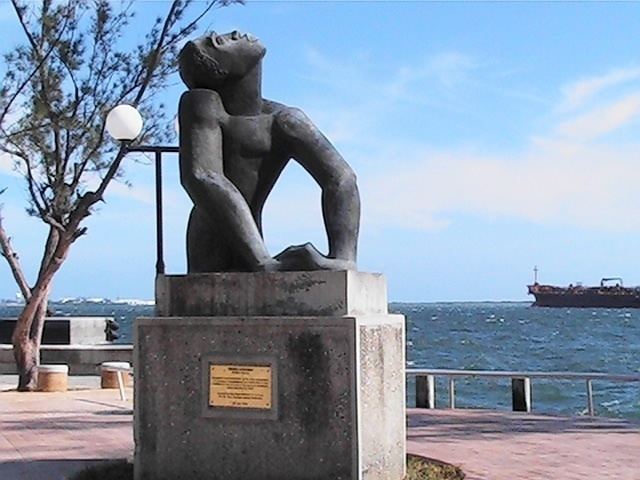 | ||
Jamaican art dates back to Jamaica's indigenous Taino Indians who created zemis, carvings of their gods, for ritual spiritual purposes. The demise of this culture after European colonisation heralded a new era of art production more closely related to traditional tastes in Europe, created by itinerant artists keen to return picturesque images of the "new world" to Europe. Foremost among these were Agostino Brunias, Philip Wickstead, James Hakewill and J. B. Kidd.
Contents
Perhaps the earliest artist to take a more Jamaican-centered approach to the island culture was Isaac Mendes Belisario (1795–1849). His portfolio of lithographs, Sketches of Character, In Illustration of the Habits, Occupation, and Costume of the Negro Population in the Island of Jamaica, published in collaboration with the lithographer Adolphe Duperly in 1837–38, documents activities of slaves immediately after their emancipation.
The modern movement
The National Gallery of Jamaica dates the nationalist-oriented art movement to the beginning of the twentieth century and the arrival of Edna Manley to Jamaica in 1922. Her observations and journals on art and artists from that time have provided early documentation on the movement's development. Her work, Bead Seller (1922), has been used as the earliest work in the National Gallery of Jamaica's permanent collection of mode. Educated in the UK, she publicly criticized Jamaica's local artwork as "anaemic," believing that it demonstrated a preoccupation with European-styled landscapes and portraiture, using traditional techniques that insufficiently reflected Jamaica's culture and people.
Her support of volunteer art classes at the Institute of Jamaica fostered the talents of artists such as Albert Huie, Ralph Campbell, Henry Daley, and Osmond Watson. The classes eventually became formalized into an art program offered at the Jamaica School of Art, an institution that was later named the Edna Manley College of Visual and Performing Arts, as a tribute to her contribution.
During the 1950s and 1960s, many of Jamaica's artists received formal training in Britain as a result of scholarships provided by the British Council. Ralph Campbell attended classes at Goldsmiths College; Barrington Watson trained at the Royal College of Art; and Osmond Watson studied at St Martins. Each artist developed his own representational style, influenced by post-impressionism, realism, and cubism, respectively. All three artists returned to teach at the Jamaica School of Art.
Since the island declared independence in 1962, Jamaican art has swung between two styles that Chief Curator, David Boxer, has defined as "mainstream" and "intuitive." "Mainstream" references Jamaica's trained artists, more often exposed to art trends and styles used abroad. The 'intuitive' movement consists of artists who maintain stronger links with African forms of expression, are predominantly closed to any external influences, and are usually self-taught. During the 1980s, a trend towards the fusion of these two styles was apparent in the work of artists such as Milton George, Robert Cookhoorne (aka African or Omari Ra), and Douglas Wallace (aka Makandal or Khalfani Ra). Smithsonian curator Vera Hyatt labelled them New Imagists, referencing the way the body in convulsive forms dominates their canvases.
Recent trends
In the 1990s, a greater awareness of post-modern trends and a connection with Jamaica's wider diaspora communities in Britain, Canada, and the US saw many artists such as Albert Chong, Anna Henriques, Petrona Morrison, Margaret Chen, and David Boxer reappraising their personal cultural histories. They began revisiting the sites of their ancestral origins (be they indigenous Amerindian cultures, African, or European), having a greater need to understand and visualise the Jamaican experience and their own sense of place within the Caribbean. But events in Jamaica have overtaken these concerns, turning an even younger generation of artists' attention inwards.
Many of Jamaica's contemporary artists in the 1990s were concerned with post-colonial issues of identity and place. They explored these issues through group shows, such as the Caribbean Biennales other and regional exhibitions. This allowed them to establish commonality with artists from other islands.
The art of this past decade appears to be shifting in focus once again. Younger artists, such as Ebony G. Patterson, Michael Elliot, Phillip Thomas, Christopher Irons, and Peter Rickards, are engaging with issues of violence, homophobia, and social dislocation that have been a feature of Jamaica's recent past. These are events and trends that are still unfolding, but they suggest that this generation of artists is having to compete with the more glaring aspects of the country's popular culture related to dance hall, ghetto fabulous fashions, street art, and the aesthetics of bling funerals for a stake in the nation's visual memory.
